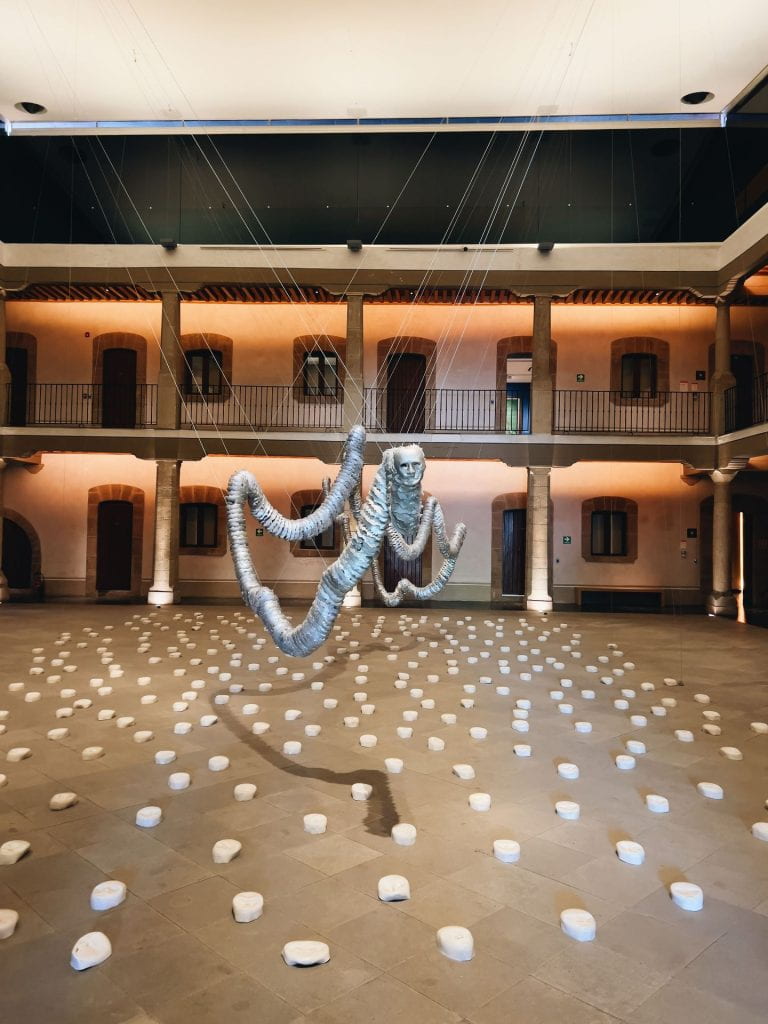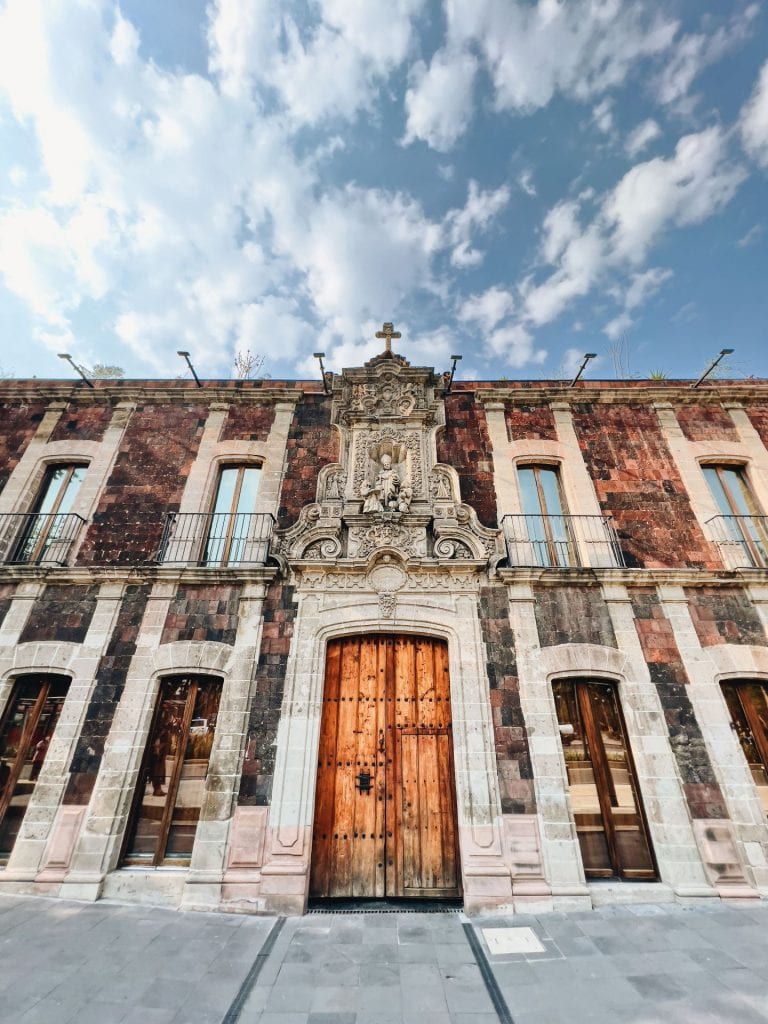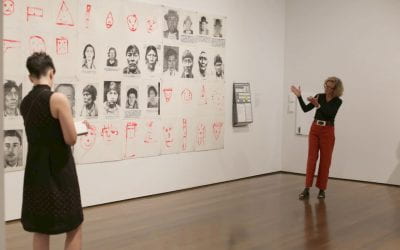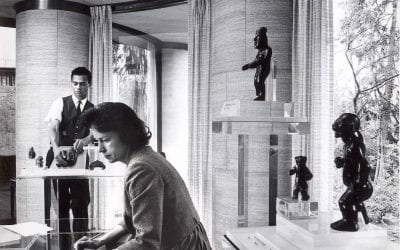Kaluz Museum
The History of a Private Collection Made Public
The history of Museo Kaluz is not that different from that of many museums that have their origin in private collections formed over the years by a collector or a family. It all starts with the formation of a collection of art, especially Mexican painting, selected from the point of view of my father, Antonio del Valle Ruiz. Although in its beginnings the incipient collection hung on the walls of our houses and offices, its growth was triggered by the desire to support the recovery of Mexican artistic heritage with a genuine desire to bring it into the public realm. That is, the Kaluz Collection was born to be shared and perhaps that is its most special quality. This spirit of showing it to the public reflects my father’s conviction that “someone who enters a museum, leaves with an exalted spirit, becoming a better person.” So basic, but also fundamental, is the essence of this project: to appeal trough art, to the most elementary goodness of the human condition.
Kaluz Museum is, therefore, the result of our family’s commitment to protect and disseminate the cultural values of our wonderful country through art.
The project, in addition to preserving, conserving, researching and disseminating an art collection, contributed to the safeguarding of our heritage through the restoration and adaptation of a historic building, the rescue of public space and the regeneration of the environment where it is located. It is also about exploring and living our traditions and generating new lines of research on topics little explored in our art history.
Our headquarters is on Avenida Hidalgo, on the corner with, Paseo de la Reforma, in front of the Alameda Central, Mexico City’s emblematic park. The building, whose construction dates back to the 18th century, was originally the Hospedería de Santo Tomás de Villanueva, an enclosure that welcomed the Spanish friars prior to their journey towards the evangelization of the East. Its splendid façade of chiluca and tezontle—volcanic rocks used in construction— is a jewel of viceregal architecture. In the 20th century, the building was Hotel de Cortés until it became the headquarters of the Kaluz Museum.
A team of experts, who worked under the supervision of the National Institute of Anthropology and History, was in charge of the building’s restoration and adaptation. Every effort was made to allow the premises to fulfill its new mission of becoming a cultural center for the city, located on one of the oldest roads of the Americas: the Calzada Mexico-Tacuba. At the same time, we proposed to the city authorities an urban transformation plan of a segment of the Calzada, known today as Avenida Hidalgo. The plan contemplated the widening of sidewalks, safe pedestrian crossings, benches, trees, lighting and a traffic reassessment to give priority to pedestrians.

The museum’s terrace, garden, and urban observatory to appreciate the Alameda Central, the Latin American Tower, and the Secretary for Foreign Affairs.
The city government welcomed the project as this area was part of its intervention plans. Thus, not only was the avenue transformed, but the entire neighborhood was reformed, significantly improving the quality of life of its inhabitants. Currently we continue to work hand in hand with the authorities and various allies so that this transformation is not only physical but social, supporting the creation of community networks and promoting cultural and peacebuilding projects in the area.
In keeping with this spirit to recover the historic neighborhood of Santa María la Redonda, which was in frank deterioration, we invited Vicente Rojo, a groundbreaking 20th-century Mexican plastic artist, to create a mural intervention on the façade of the building that overlooks the Paseo de la Reforma. This wall was visually neglected due to the mutilation it suffered by the extension of Paseo de la Reforma in the 1960s. The result of his work was a magnificent stone mural entitled “Urban Garden,” made up of ten vertical panels that dialogue with the forms and lines of the colonial façade. It is actually an abstract landscape that is a subtle reference to the Alameda and the Kaluz Collection itself, in which the landscape is remarkably featured. The mural becomes the main presence of a small public square that receives thousands of users daily coming out from the Hidalgo Metro station and has become an urban reference of the city.

A detail of the “Urban Garden” mural by Vicente Roj.
The adaptation of the building lasted approximately four years, in which work was done to achieve a plural space with 10,075 feet of exhibition area, a room for workshops, a small auditorium, a cafeteria and a restaurant. The covered central courtyard has multiple uses, and we also have a terrace that serves as a lookout point over the city center. Our dynamic museum store offers new items of Mexican designers and artisans are, as well as a line of products related to the collection and exhibitions. A rainwater collection system was installed, allowing us to efficiently save on the use of water.
Finally, the museum was ready to open to the public. We managed to do it despite the pandemic and on November 25, 2020, we opened with an exhibition that presented a careful selection of works from our collection. Under the title “Mexico and the Mexicans in the Kaluz Collection,” the exhibition proposes a journey through the genres of our collection of Mexican figurative painting that ranges from the 18th century to the present day. That is, a journey through landscape, still life, portrait and customs, genres that at the end of the day speak of us as a country: our spaces, our food and our things, our people and our traditions. The exhibition is consistent with our desire to exalt Mexican values, what makes us unique and gives us identity.

One of the rooms in the “Mexico and the Mexicans” exhibition.
The museum’s exhibition program proposes the collection itself as a trigger for reflection appreciation and contemplation. Made up of about 1,500 works, our collection seeks to establish a dialogue between artists of all times, managing to put on stage the great representatives of Mexican art, next to those less favored by the history of art or the market. We can see works by Gerardo Murillo (Dr. Atl) or José Agustín Arrieta, some of the authors who initially entered the collection, dialoguing with works by Francisco Romano Guillemín or Cleofas Almanza, to mention just a few, along with living contemporary painters. Without making a linear review of the history of Mexican art, the collection has been formed through the eyes and taste of its founder. It is currently exploring the criteria and how the acquisitions will be increased over the near future. This includes the strengthening of one of the nuclei that make it unique and particularly special: the inclusion of the works of the Spanish painters who found refuge in Mexico due to the Spanish Civil War.
The first works of these artists came to the collection because my father had a very dear friend, a descendant of exiles, who introduced him to the works of Antonio Rodríguez Luna and Arturo Souto, great masters who came to our country at the end of the Spanish Civil War. When my father made the decision to share his collection with the general public, he took special care on addressing this group of painters who had been suspended between two nations, with an evident identity crisis. It was then that he acquired works by other great exponents of painting such as Roberto Fernández Balbuena, Enrique Climent, Ramón Gaya, Elvira Gascón and Manuela Ballester, among many other exiles. And so, the collection became a great repository in which the work of these artists, often forgotten, is being cared for and studied in the hope that it will find its place within the history of Mexican, Spanish and universal art.
In response to this initiative, we received in donation a wonderful set of drawings by Francisco Marco Chilet, made in the French concentration camps at the end of the Civil War. In a generous and selfless way, the descendants of the artist put in our hands this formidable body of work, which we received with deep gratitude, assuming the commitment to restore it, study it and share it with the public and the academic community.
The exhibitions we have planned for the near future will seek to strengthen this interest in inclusion, as well as dialogues between artists. In the central courtyard, which is designed to be used for multiple purposes, we plan to host an installation related to the Day of the Dead every November and on other occasions it will become a space for contemporary expressions addressing current issues, within the framework of Zona Maco, a contemporary art fair in Mexico City. For the second half of this year, we have scheduled a special exhibition about women artists.

“The Serpent of the Days”, an installation by Carlos Amorales in the courtyard.
We can’t help but think about the Museum’s sustainability and permanence over time, which is one of our main challenges. As in family businesses, it is necessary to reach a high degree of institutionalization, in order to grow. This implies starting to make difficult decisions regarding philosophy and governance, the administration and enrichment of the collection, the sources of financing, and the relevance of what is presented.
As for philosophy and governance, we are assuming with objective reflections, the commitment to achieve a greater institutionalization of this project of family origin, to turn it into an independent endeavor.
As for the collection, we are rethinking how its growth should take place, moving from the decision of a single collector to a collegiate group that includes independent experts. In the same way we are redefining our storage and conservation processes, as well as the way we manage information: its registration and cataloging, capital to facilitate decision making.
With regard to the financing of the project, we need to be actively creative in the generation of new sources of income. But perhaps one of the biggest challenges, is to be able to shape a project that is attractive enough to bring not only those new sources of income, but also the interest of a young audience looking for novel and stimulating cultural experiences. This will allow us to fulfill our goal of triggering within us the flourishing of the best of human condition.
I would be very pleased to come back to this space in a few years and share how we have advanced in these great challenges. Even if we walk slowly we will have advanced some of the way, but above all we will have enjoyed ourselves.
For now, I invite you to visit our project that adds to the formidable cultural offer of Mexico City.

The museum’s sculpted facade.
Museo Kaluz
Historia de Una Coleción Privada Hecha Pública
Por Blanca del Valle Perochena
La historia de Museo Kaluz, no debe de ser muy diferente a la de muchos museos que tienen su origen en colecciones privadas formadas a través de los años por un coleccionista o una familia. Todo comienza, con la formación de una colección de arte, sobre todo de pintura mexicana, a través de la mirada de mi padre, Don Antonio del Valle Ruiz. Si bien en sus inicios el incipiente acervo colgaba en las paredes de nuestras casas y oficinas, su crecimiento se detonó por el anhelo de apoyar en la recuperación y la promoción de nuestro patrimonio artístico con un genuino deseo de socializarlo. Es decir, la Colección Kaluz nació para compartirse y quizá ésa sea su cualidad más especial. Este ánimo de ponerla a escena en un espacio, es directamente proporcional a la convicción de mi padre de que “alguien que entra a un museo, sale con el espíritu enaltecido, siendo una mejor persona”. Así de básica, pero también de fundamental, es la esencia de este proyecto: apelar a la bondad más elemental de la condición humana a través del arte.
Museo Kaluz es entonces, el resultado del compromiso de nuestra familia de proteger y difundir los valores culturales de nuestro maravilloso país, a través del arte.
El proyecto, además de preservar, conservar, investigar y difundir una colección de arte, contribuyó en la salvaguarda de nuestro patrimonio a través de la restauración y adecuación de un edificio histórico, así como del rescate del espacio público y la regeneración del entorno donde se encuentra. Se trata también de explorar y vivir nuestras tradiciones y de generar nuevas líneas de investigación sobre temas poco explorados de nuestra historia del arte.
Nuestra sede se encuentra sobre Avenida Hidalgo, donde hace esquina con el Paseo de la Reforma, frente a la Alameda Central, el emblemático jardín de la Ciudad de México. El edificio, cuya construcción se remonta al siglo XVIII, fue originalmente la Hospedería de Santo Tomás de Villanueva, un recinto que recibía a los frailes españoles previo a su trayecto hacia la evangelización de Oriente. Su esplendorosa fachada de chiluca y tezontle es una joya de la arquitectura virreinal, que en siglo XX funcionó como entrada para el célebre Hotel de Cortés, vocación que sostuvo hasta convertirse en la sede del Museo Kaluz.
Para el proyecto de restauración y adaptación, estuvo a cargo un equipo de expertos, quienes trabajaron en colaboración y supervisión del Instituto Nacional de Antropología e Historia, para que el edificio pudiera cumplir con su nueva misión de ser un centro de difusión cultural para la ciudad, situado en una de las calzadas más antiguas de la traza urbana de la metrópoli: la México-Tacuba. En paralelo, propusimos a las autoridades de la ciudad un proyecto de transformación urbanística y vial de un tramo de esta misma calzada hoy conocido como la Avenida Hidalgo. Esta remodelación contempló el ensanchamiento de la acera, cruces peatonales seguros, mobiliario urbano como bancas, jardineras, iluminación y el replanteamiento del arroyo vehicular, para privilegiar al espacio peatonal.

La terraza del museo, su jardín y el observatorio urbano para apreciar la Alameda, la Torre Latinoamericana y la Secretaría de Relaciones Exteriores.
El Gobierno de la ciudad recibió con beneplácito el proyecto, pues esa zona estaba dentro de sus planes de intervención. Así, no sólo se transformó la avenida, sino que se reformó todo el barrio, mejorando significativamente la calidad de vida de sus habitantes. Actualmente seguimos trabajando de la mano de las autoridades y diversos aliados para que esta transformación no sea solo física sino social, apoyando la creación de redes comunitarias e impulsando proyectos culturales y de construcción de paz en la zona.
En sintonía con ese espíritu de recuperación del barrio histórico de Santa María la Redonda, que se encontraba en franco deterioro, invitamos al maestro Vicente Rojo, un artista fundamental de la plástica mexicana del siglo XX, a hacer una intervención mural en la fachada del edificio que da al Paseo de la Reforma, un muro que se encontraba visualmente descuidado debido a la mutilación que sufrió el edificio por la prolongación de Reforma en la década de los años 60 del siglo XX. El resultado de su trabajo fue un magnífico mural pétreo intitulado “Jardín urbano”. Modulado en diez paneles verticales que dialogan con las formas y líneas de la propia fachada colonial, es en realidad un paisaje abstracto que hace un guiño a la Alameda y a la propia Colección Kaluz, en la que el paisaje se exalta notablemente. El mural se convierte en el protagonista de una pequeña plaza pública que recibe a diario a miles de usuarios al salir de la estación Hidalgo del Metro y que se ha convertido en un referente urbano de la ciudad.

Un detalle del mural pétreo “Jardín Urbano” de Vicente Roj
La adecuación del edificio duró aproximadamente cuatro años, en los que se trabajó para conseguir un espacio plural con mil metros cuadrados de área de exposición, salón para talleres, un pequeño auditorio, cafetería, restaurante, además del patio central cubierto para usos múltiples, un mirador y una dinámica tienda de museo, en la que se ofrecen novedosos artículos de diseñadores y artesanos mexicanos, así como una línea de productos relacionados a la colección y las exposiciones. Se instaló un sistema de captación de aguas pluviales, lo que nos permite un eficiente ahorro en el uso del agua.
Finalmente el museo estuvo listo para abrirse al público. Conseguimos hacerlo a pesar de la crisis sanitaria que azotó al mundo y, el 25 de octubre del 2020 inauguramos con una exposición que presentaba una cuidada selección de obras de nuestro acervo. Bajo el título de “México y los mexicanos en la Colección Kaluz”, la muestra planteó un recorrido por los géneros que aborda una colección de pintura figurativa mexicana desde el siglo XVIII a nuestros días. Esto es, un recorrido por la pintura de paisaje, la naturaleza muerta, el retrato y la pintura de costumbres, géneros que al final del día hablan de nosotros como país: nuestro espacio, nuestra comida y nuestros utensilios, nuestra gente y nuestras tradiciones. La exposición es consecuente con nuestro deseo de exaltar los valores de lo mexicano, aquello que nos hace únicos y nos da identidad.

Vista de una sala de la exposición “México y los mexicanos”
El programa expositivo del museo propone a la propia colección como un detonante de reflexión, apreciación y contemplación. Formado por alrededor de mil quinientas obras, nuestro acervo busca establecer un diálogo entre artistas de todos los tiempos y ambiciona ser propositivo desde su condición colectiva, consiguiendo poner en el escenario a los grandes representantes de nuestra pintura al lado de los menos favorecidos por la historia del arte o el mercado, pero que juntos dan forma a nuestro imaginario plástico. Así es que podemos ver obras de Gerardo Murillo (Dr. Atl) o José Agustín Arrieta, algunos de los autores que ingresaron inicialmente a la colección, dialogando con obras de Francisco Romano Guillemín o Cleofas Almanza, por mencionar solo a algunos, junto con pintores vivos y de nuestro tiempo. Sin obligación de hacer un repaso lineal de la historia del arte mexicano, la colección se ha formado a través de la mirada y el gusto de su fundador. Actualmente explora los criterios y la manera en que el acervo se incrementará en el futuro cercano. Esto incluye el fortalecimiento de uno de los núcleos que la hacen particularmente especial y única: la inclusión en ella de las obras de los pintores del exilio español en México.
Las primeras obras de estos artistas llegaron a la colección porque mi padre tenía un muy querido amigo que era descendiente de exiliados y, lo introdujo a las obras de Antonio Rodríguez Luna y Arturo Souto; grandes maestros que llegaron a nuestro país al concluir la guerra civil española. Cuando Don Antonio tomó la decisión de formar este acervo que compartiría con el público, tuvo especial cuidado de que la colección abordara de manera consciente a este grupo de pintores que habían quedado suspendidos entre dos naciones, con una evidente crisis de identidad. Fue entonces que adquirió obras de otros grandes exponentes de la pintura como Roberto Fernández Balbuena, Enrique Climent, Ramón Gaya, Elvira Gascón, Manuela Ballester, entre otros muchos exiliados. Y así la colección se convirtió en un gran repositorio en el que el trabajo de estos artistas, muchas veces olvidado, está siendo cuidado y estudiado con la esperanza de que encuentre su lugar dentro de la historia del arte mexicano, del arte español y del arte universal.
En respuesta a esta iniciativa, recibimos en donación un maravilloso conjunto de obras realizadas por Francisco Marco Chilet en dos campos de concentración franceses al finalizar la Guerra Civil. De manera generosa y desinteresada, los descendientes del artista pusieron en nuestras manos este formidable cuerpo de obra, mismo que recibimos con profundo agradecimiento, asumiendo el compromiso de restaurarlo, estudiarlo y compartirlo con el público y la comunidad académica.
Las exposiciones que tenemos planeadas para el futuro cercano buscarán fortalecer este interés de inclusión, así como de diálogo entre artistas. En el patio central, cuya vocación hemos definido de flexible, presentaremos cada noviembre una instalación relacionada con el Día de Muertos y en otras ocasiones se convertirá en un espacio para expresiones contemporáneas que aborden temas de actualidad, en el marco de Zona Maco, una feria de arte contemporáneo en la Ciudad de México. En las salas temporales, una muestra de mujeres artistas está programada para el segundo semestre de este año.

“La serpiente de los días” una instalación de Carlos Amorales en el patio del museo
No podemos dejar de pensar en su sostenibilidad y permanencia a través del tiempo, que es uno de nuestros principales desafios. Como en las empresas familiares, para poder crecer y profesionalizarse se necesita llegar a un grado alto de institucionalización, lo que implica empezar a tomar decisiones dificiles realacionadas con la filosofía y gobernanza, la administración y enriquecimiento de la colección, las fuentes de financiamiento y obtención de recursos y la pertinencia de lo que se presenta.
En cuanto a la filosofía y gobernanza, estamos asumiendo con reflexiones objetivas, el compromiso de lograr una mayor institucionalización de este proyecto de origen familiar, para convertirlo en algo más independiente.
En cuanto a la colección, estamos replanteando como debe de darse su crecimiento, pasando de la decisión de un solo coleccionista a un grupo colegiado que incluye expertos independientes. De la misma manera estamos redefiniendo nuestros procesos de almacenaje y conservación, así como la forma en que que administramos la información: su registro y catalogación, capitales para facilitar la toma de decisiones.
En lo referente al financiamiento del proyecto, tenemos que ser ser activamente creativos en la generación de nuevas fuentes de recursos, Pero quizá uno de los retos más grandes es el poder darle forma a un proyecto que sea lo suficientemente atractivo para poder atraer no solo esas posibles fuentes de financiamiento, sino también el interés de un público joven que busca experiencias culturales novedosas y estimulantes, que nos permita cumplir con nuestro objetivo de ser un detonante para que florezca en nosotros lo mejor de la condición humana.
Me daría mucho gusto regresar a este espacio en algunos años y compartir con ustedes cómo hemos avanzado en estos grandes retos. Aunque vayamos despacio, habremos recorrido algo del camino, pero sobre todo habremos disfrutado mucho como lo estamos haciendo en este momento.
Por lo pronto, los invito a visitarnos y a que conozcan el principio de nuestro proyecto que se suma a la formidable oferta cultural de la Ciudad de México.

Fachada del museo Kaluz con la portada esculpida de la entrada.
Blanca del Valle Perochena is the Executive Chair of the Kaluz Museum.
Blanca del Valle Perochena es la Presidente ejecutiva del Museo Kaluz.
Related Articles
Editor’s Letter – Museums
Editor's LetterMuseums. They are the destination of school field trips, a place to explore your own culture and a great place to run around and explore. They are exciting or boring, a collection of objects or a powerful glimpse into other worlds. Until recently—with...
Art and Public
As Curator of Modern and Contemporary Art at the Harvard Art Museums, I seek to expand the presence of artists from across the world in our collection.
A View of Dumbarton Oaks
Dumbarton Oaks, once the Georgetown home of Robert and Mildred Bliss, is Harvard’s multi-varied Humanities Center in the heart of Washington DC.



